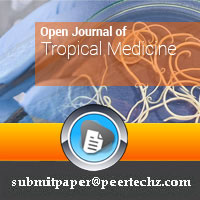Open Journal of Tropical Medicine
Leishmania-sandfly interactions
Sajida Sboui1 and Ahmed Tabbabi2*
2Department of Hygiene and Environmental Protection, Ministry of Public Health, Tunis, Tunisia
Cite this as
Sboui S, Tabbabi A (2018) Leishmania-sandfly interactions. Open J Trop Med 2(1): 001-001. DOI: 10.17352/ojtm.000006Short Communication
There is a specific association between insect vector species and parasites [1]. The susceptibility or resistance of a species of sandfly to the development of a particular parasite depends on its ability to overcome certain barriers such as the proteolytic enzymes of the midgut, the peritrophic membrane surrounding the blood meal, and excretion of the midgut contents during digestion [2].
As for digestive enzymes, proteophosphoglycans (PPGs) and acid phosphatases form a matrix that decreases the amount of digestive enzymes in the intestine and their negative charges protect the parasite from the hydrolysing effect of nearby proteolytic enzymes [2]. To survive, Leishmania must be able to escape quickly from the peritrophic membrane. This membrane is, among others, composed of chitin and it seems that the parasite could lyse it through the production of a chitinase [3]. Finally, the parasite must be able to attach to the epithelial cells of the intestine in order to escape its elimination during the excretion of the blood meal. This attachment is achieved through interaction between LPG (lipophosphoglycan) and intestinal epithelial cells [4].
Thus, the galactose residue branching of LPG of Leishmania major would allow its attachment in its natural vector Phlebotomus papatasi whereas Leishmannia donovani cannot attach to it because of its unbranched LPG [5]. In contrast, Leishmania major and Leishmania donovani cannot colonize the midgut of Phlebotomus sergenti, a natural vector of Leishmania tropica. Thus, differences in structure between LPGs of different Leishmania species would be responsible for their survival in their respective vectors [6]. The parasitic specificity in the Leishmania / sandfly pair seems to be flexible and not completely strict [7]. There may indeed be several species of permissive sandflies. Thus, Phlebotomus arabicus replaces Phlebotomus sergenti in Leishmania tropica transmission in a Near Eastern focus [8]. Phlebotomus (Adlerius) halepensis is susceptible to Leishmania major and Leishmania tropica [9]. Phlebotomus dubosqi and Phlebotomus papatasi show the same receptor for Leishmania major [10].
- Killick-Kendrick R (1990) Phlebotomine vectors of the Leishmaniases: a review. Med. Vet. Entomol 4: 1-24. Link: https://goo.gl/8sfaw3
- Sacks D, Kamhawi S (2001) Molecular aspects of parasite-vector and vector -host interactions in Leishmaniasis Annual Review of Microbiology. 55: 453-483. Link: https://goo.gl/Bv1LVA
- Schlein Y, Jacobson RL, Shlomai J (1991) Chitinase secreted by Leishmania functions in the sandfly vector. Proc R Soc Lond Ser B 245: 121- 126. Link: https://goo.gl/ZComjV
- Kamhawi S, Modi GB, Pimenta PFP, Rowton E, Sacks DL (2000) The vectorial competence of Phlebotomus sergenti is specific for Leishmania tropica and is controlled by species-specific, lipophosphoglycan mediated midgut attachment. Parasitology 121: 25-33. Link: https://goo.gl/gWxWd6
- Pimenta PF, Saraiva EM, Rowton E, Modi GB, Garraway LA, et al. (1994) Evidence that the vectorial competence of phlebotomine sand flies for different species of Leishmania is controlled by structural polymorphisms in the surface lipophosphoglycan. Proc Natl Acad Sci USA 91: 9155-9156. Link: https://goo.gl/b6dwTM
- Forget G (2004) Étude des mécanismes de régulation négative utilisés par Leishmania pour contrer la réponse immunitaire innée. Thèse de doctorat. Université Laval. 300. Link: https://goo.gl/a9TTnV
- Volf P, Myskova J (2007) Sand flies and Leishmania: specific versus permissive vectors. TRENDS in Parasotilogy 23: 3. Link: https://goo.gl/jq5qZf
- Jacobson RL, Eisenberger CL, Svobodova M, Baneth G, Sztern J, et al. (2003) Outbreak of Cutaneous Leishmaniasis in Northern Israel. J Infec Dis 188: 1065-1073. Link: https://goo.gl/h7Eg2U
- Sadlova J, Hajmova M, Volf P (2003) Phlebotomus (Adlerius) halepensis vector competence for Leishmania major and Le. tropica Med Vet Entomol 17: 244–250. Link: https://goo.gl/mqG5zr
- Kamhawi S, Ramalho-Ortigao M, Pham VM, Kumar S, Lawyer PG, et al. (2005) Identification of the receptor of Leishmania major Lipophosphoglycan from the midgut of P. papatasi. ISOPS V, Arch Inst Pasteur Tunis 82: 35- 36.
Article Alerts
Subscribe to our articles alerts and stay tuned.
 This work is licensed under a Creative Commons Attribution 4.0 International License.
This work is licensed under a Creative Commons Attribution 4.0 International License.

 Save to Mendeley
Save to Mendeley
